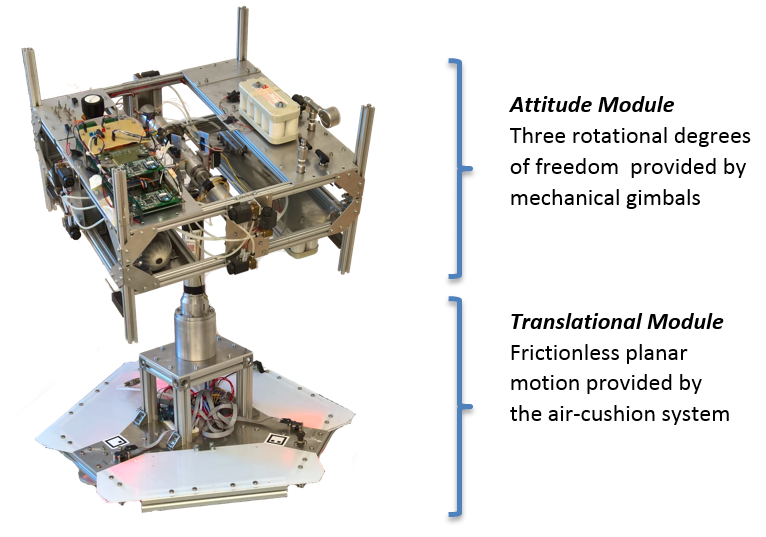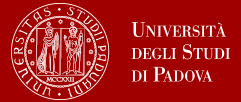SPARTANS Facility - Project Description
SPARTANS Mini-satellite Simulator
Sponsoring Departments and Research Centers:
University of Padova - CISAS "Giuseppe Colombo"
University of Padova - Department of Industrial Engineering
Contacts
email: enrico.lorenzini@unipd.it web link: www.cisas.unipd.it
Team
Principal Investigator:
Enrico Lorenzini (Professor)
Co-Investigators:
Andrea Valmorbida (Postdoc)
Mattia Mazzucato (PhD student)
Sergio Tronco (PhD student)
Master's Degree Students in Aerospace Engineering:
Andrea Caon, Andrea Bellato, Francesco Scarpa, Luca Bottaro, Fabio Scibona, Marco Costantini, Alberto Guzzo
Motivation
There is a growing need for ground-based facilities to reproduce the microgravity or low-gravity environment typical of satellites on orbit. These facilities are used to assist scientists and engineers in the design and validation of both navigation and control algorithms and new technologies that are fundamentals for future space missions, e.g., Automated Rendezvous and Docking (ARD), On Orbit Servicing and Assembly (OOS&A) and Satellite Formation Flying (SFF).
In the last decade, space agencies, research institutes and universities have invested resources in the development of these kinds of facilities. For instance, JPL-CalTech developed the Formation Control Testbed (FCT), ESA is completing the GNC Rendezvous, Approach and Landing Simulator (GRALS) testing facility, and DLR is developing the Test Environment for Applications of Multiple Spacecraft (TEAMS). Examples of such testbeds developed by universities are the MIT Synchronized Position Hold, Engage, and Reorient Experimental Satellites (SPHERES) system and other low-friction facilities at various universities around the world. Most of the university facilities concentrate on the frictionless motion of a satellite module on a flat table but do not combine the translation and attitude motions.
Our research Group for Measurement and Space Technology (GMST) of the University of Padova has been developing a single and pair-spacecraft testbed for autonomous proximity operations experiments, called SPARTANS, that combines the translation and attitude motion of the satellite modules. The facility is aimed at conducting research in the fields of Automated Rendezvous & Docking, Satellite Formation Flight, Vision-based Navigation, Identification of Motion of Tumbling Objects and other applications involving the relative dynamics and control of vehicles in proximity, that require combining their position and attitude motions.
SPARTANS Facility
The SPARTANS project started in 2010 as a University of Padova sponsored project with the aim of realizing a representative laboratory facility to carry out both research and educational activities mainly in the fields of ARD and SFF. The project is conducted by Ph.D. students in Aerospace Engineering, Postdocs and Master's Degree students under the supervision of Prof. Enrico Lorenzini with the support of the research center UniPD-CISAS "Giuseppe Colombo" and the Department of Industrial Engineering of our university. The SPARTANS facility consists of: (a) two Spacecraft Modules; (b) an external Control Station (computer); (c) a 2m x 3m glass-covered flat table over which the Spacecraft Modules can "float" with no friction thanks to an air-cushion system; and (d) a Global Navigation system, consisting of six external IR cameras that provide a fiducial reference of linear position and attitude (pose) of each Spacecraft Module. This two-vehicles testbed can provide a representative dynamic environment for the development and verification on the ground of coupled position and relative attitude Guidance Navigation and Control (GNC) algorithms, Vision-based Navigation, Identification of Motion of a Tumbling Spacecraft, Collision Avoidance Maneuvers, Coordinated Retargeting and other techniques that are related to the formation flight of satellites in proximity conditions.
The SPARTANS facility consists of: (a) two Spacecraft Modules; (b) an external Control Station (computer); (c) a 2m x 3m glass-covered flat table over which the Spacecraft Modules can "float" with no friction thanks to an air-cushion system; and (d) a Global Navigation system, consisting of six external IR cameras that provide a fiducial reference of linear position and attitude (pose) of each Spacecraft Module. This two-vehicles testbed can provide a representative dynamic environment for the development and verification on the ground of coupled position and relative attitude Guidance Navigation and Control (GNC) algorithms, Vision-based Navigation, Identification of Motion of a Tumbling Spacecraft, Collision Avoidance Maneuvers, Coordinated Retargeting and other techniques that are related to the formation flight of satellites in proximity conditions.
Technology
A new design of a flat table was developed that does not utilize the very heavy and expensive optical tables normally used for this type of facilities. The flat table enables a practically frictionless motion of the Spacecraft Module(s) through the air pads of the suspension module.

A very low-friction, mechanical joint placed at the center of mass of the S/C module enables a 3-degrees-of freedom (DOF) attitude motion that, combined with the 2-DOF planar motion, gives a 5-DOF to each spacecraft module. The azimuth motion (about the vertical axis) is unconstrained over 360° and the very low friction of the joint decouples the attitude motion of the module from the rotation of the supporting base. The motion about the pitch and roll axes are mechanically limited to within ±45°. Three optical encoders, embedded into the rotational joints, provide a fiducial system for the rotations of the spacecraft module with respect to its initial attitude.
The attitude module hosts most of the subsystems of a mini-satellite: power, propulsion, on-board data handling, an Inertial Measurement Unit (IMU) with 3 gyros, 3 accelerometers and a magnetometer, communication link with the control base, and optional added sensors for the relative navigation (e.g. a stereo camera for vision-based navigation).
The suspension module consists of air tanks, pressure regulator and three air-cushion pads to "float" the attitude module and to enable translation over the flat table with practically no friction.
Six Infra-red (IR) cameras, external to the flat table, track IR reflectors on board the attitude module(s) to give the position of the module and its attitude (pose) with reference to the external, global frame.
Three no-contact, optical mouse sensors placed on board the suspension module give the incremental displacement of the attitude module on the flat table with respect to its initial position.
Dedicated software packages handle the position and attitude estimation, the data collection, control algorithms, and actuation of the cold-gas propulsion system of the Spacecraft Module(s).
In parallel, a software simulator was developed to simulate the dynamics of the Spacecraft Module and its sensors. This S/W simulator is used to develop the control algorithms that are then tested on the hardware-in-the-loop SPARTANS facility.
Present Status
 After several years of development, the facility has become operational both for the attitude and planar motion of one Spacecraft Module while a second Spacecraft Module is in construction. The attitude joints and the air cushion system provide an ultra-low friction level. The IR camera system has been calibrated and works at a level of accuracy better than 1 mm in position and 0.1° for the attitude determination.
After several years of development, the facility has become operational both for the attitude and planar motion of one Spacecraft Module while a second Spacecraft Module is in construction. The attitude joints and the air cushion system provide an ultra-low friction level. The IR camera system has been calibrated and works at a level of accuracy better than 1 mm in position and 0.1° for the attitude determination.
The present plan is to complete the development of the facility, the construction of the second Spacecraft Module, and to add the on-board stereo-camera vision system for carrying out maneuvers of automated rendezvous and docking, satellite formation flying, and other close-proximity operations.






